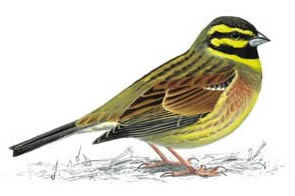 |
|||||||||
|
|||||||||||||||||||
|
|
UK’s Rarest Farmland Bird Fights Back with the Help of Farmers 2010-02-16 New survey results show the cirl bunting – one of Britain’s most threatened songbirds - is continuing its comeback from the brink of extinction.
According to the latest figures published this week, the cirl bunting population has increased by 25 per cent since 2003, reaching 862 breeding pairs in 2009. Despite this increase, the species remains confined to a small area of Devon and Cornwall. Although their range once covered large parts of southern England and it could be heard singing from the trees of Wimbledon Common, cirl bunting populations declined massively in the second half of the 20th Century with just 118 pairs remaining in 1989. The rise in numbers follows a joint campaign by the RSPB and Natural England to help local farmers manage their land in ways that provide year-round food supplies and breeding habitat for these distinctive birds. Under the Cirl Bunting Species Recovery Programme, led by the RSPB and co-funded by Natural England, advisers visit farmers to help them choose the best agri-environment scheme options. These include grasslands, which provide invertebrates for summer food, and weedy overwinter stubble, which provide essential seed food during the colder months. Around 18 months ago the RSPB opened the Labrador Bay reserve in Devon to create a protected haven for cirl buntings – the first time the charity has bought a piece of land to save a single bird species. “This is fantastic news, we are all very excited that these fascinating birds are starting to make a comeback,” said Mark Avery, RSPB director of conservation. “Wildlife lovers come from across the UK to our reserve at Labrador Bay to catch a glimpse of the elusive cirl bunting. It has also become something of a local celebrity – even being incorporated into the emblem of a local village school. “We have learnt a lot in recent years about cirl buntings and how to protect their habitat, and now that is paying off. But we can’t take all the credit. The cirl bunting is a farmland bird and it’s down to the work farmers on the Devon coast have put in on their land that this comeback has been possible. “Farmland birds as a group have declined by 50 per cent in the past 40 years. If we can halt the decline in a dangerously threatened species like this one then there is hope for all the endangered birds in our countryside.” Tom Tew, Chief Scientist of Natural England, said: “The recovery of the cirl bunting shows what can be achieved when farmers and conservationists work together to target specific land management measures in the right place. “Biodiversity loss need not be the inevitable consequence of 21st century life and we are delighted that this rare and beautiful bird is making a comeback having come so close to being lost as a breeding bird in this country.”
|
||||||||||||||||||

|
|
||||||||||||||||||
| home | agri-services | pedigree
pen | news | dairy | beef | machinery property | organisations | site map |
|||||||||||||||||||

